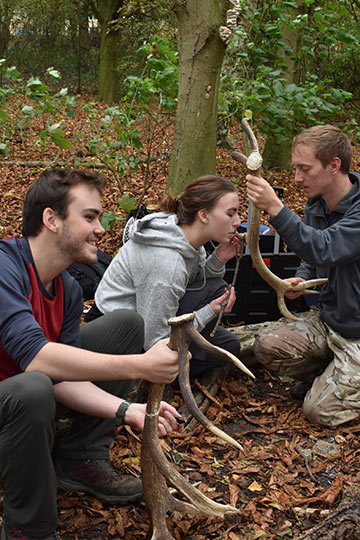Hands-on experimental archaeology at the YEAR centre
Exciting opportunities for students on the MA/MSc Material Culture and Experimental Archaeology
Postgraduate students in the Department of Archaeology have been honing their practical skills in experimental archaeology at the York Experimental Archaeological Research (YEAR) centre, located on campus.

Students tried different techniques to reduce the antler down to the desired form, using flint tools and fire
The centre is a base for the MA/MSc Material Culture and Experimental Archaeology. With bioarchaeology (BioArCh) and palaeocology (PalaeoHub) facilities located next door, students are able to carry out outdoor experiments then take their work inside for processing and analyses. This unique combination of facilities enables students to engage in exciting research and learn practical, hands-on skills.
Dr Steve Ashby, who teaches on the Viking/Medieval period, says:
‘As a specialist in craft and artefact production in the Viking period, I am really excited by the opening of the YEAR centre. This facility opens up real potential for important research to be undertaken by students. We have already engaged students in the production of Anglo-Saxon pottery, and I look forward to working on projects relating to subjects as diverse as medieval bone-working, metal-casting, glass-working, and cooking.‘
Masters students on the Experimental Archaeology Design and Practice module have already had the opportunity to work with curation and education staff at York Archaeological Trust (YAT). An artefact from YAT’s collections was chosen as the subject of experimental research at the YEAR centre.
This year’s artefact was a Neolithic antler pick from Melton, Yorkshire. Hundreds of these picks have been found at Stonehenge and are thought to have been used for digging ditches or pits, and quarrying.
The students were given the challenge of using experimental archaeology to understand the manufacture and function of this artefact whilst also producing a short documentary film about their research. The target audience of their film was primary school age children, at Key Stage 2. The films were then judged by a YAT representative, with the winning films now being used for education/outreach events and exhibitions. Several of the students have since been invited by YAT to present their work at a festival.
The work completed at the YEAR centre this year demonstrates how experimental archaeological teaching and research at York is having a real impact on how archaeology is communicated beyond the lecture theatre.